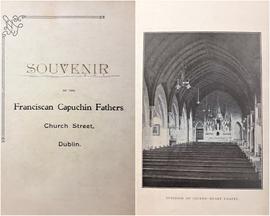File of newspaper clippings mainly re various anniversaries and commemorations connected with Fr. Theobald Mathew OSFC and the temperance campaign. Some of the clippings refer to the unveiling of a Father Mathew statue in his native Thomastown, County Tipperary. The file includes:
• ‘Memoir of Father Mathew by William Howitt’, 'The People’s Journal', 15 Aug. 1846. The copy article refers to Fr. Mathew’s ancestry.
• Clipping of an article titled ‘The Life and Labours of Father Mathew’ from the 'Irish Penny Readings'. The article reports a speech by John Francis Maguire MP at a public meeting held in the Cork City Courthouse in January 1857 to inaugurate a ‘movement for the erection of a monument in Fr. Mathew’s memory’. 121-5 pp.
• ‘Apostle of Temperance in USA’, 'The Standard', 14 Jan 1955.
• ‘Fr. Mathew / One of the Great Men of History, 'Cork Examiner', 15 Nov. 1956.
• ‘Archbishop Mathew’s Tributes to his Illustrious Kinsman’, 'Cork Examiner', 15 Dec. 1956.
• ‘Myles na Gopaleen’ (Brian O’Nolan, 1911-1966), ‘Father Mathew’, 'Irish Times', 18 Dec. 1954 and 13 Jan. 1955. A negative pen-portrait of Fr. Mathew and his temperance campaign.
• Denis Gwynn, ‘Now and then / Father Mathew’s Grave / The Botanic Gardens’, 'Cork Examiner', 15 June 1956.
• ‘Apostle of Temperance Honoured / Kinsman Unveils Memorial at Birthplace / Tipperary Tribute’, 'Irish Independent', 26 June 1939.
• ‘Tipperary Honours the Noble Name of Mathew / Government urged to preserve Thomastown Castle as national monument’, 'The Tipperary Star', 1 July 1939.
• ‘Kilkenny honours Father Mathew / Great Temperance Rally’, 'Kilkenny Journal', 16 July 1938.
• ‘The Memory of Father Mathew / Speeches by Rev. Father Peter Bowe OSFC and the Most Rev. Dr. Kelly, Bishop of Ross’, 'Cork Examiner' [1902].
• ‘Where Fr. Mathew was threatened / Incident at Cootehill’.
• Newspaper cutting re the history of Holy Trinity (Father Mathew Memorial) Church, Cork, and Fr. Mathew’s association with the building. 'West Cork Eagle and County Advertiser', Dec. 1883. The article gives considerable detail about the interior decoration of the building. It reads: ‘There are six confessionals built of pine to correspond with the choir and gallery, and handsomely carved. The Stations of the Cross are in alto relievo, cast in composite material from designs by one of the Italian Friars who were in charge of the Church some years ago They are genuine works of art. The organ, it may not be generally known, is the instrument which was built for the Cork Exhibition of 1852 by Mr. Murphy, and is at present in as good tone as when it peals lifted up the hearts of thousands more than thirty years ago’.
• Special supplement to the 'Cork Examiner' on the Centennial Celebrations, 11 Oct. 1890.

